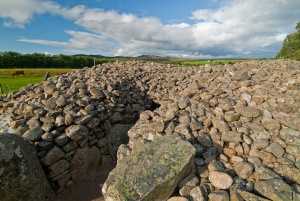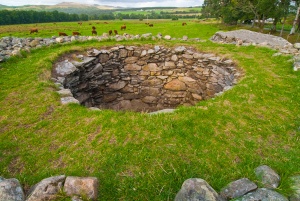
Corrimony Chambered Cairn is a superbly preserved Bronze Age passage grave in an idyllic rural location in Glen Urquhart. The burial mound is surrounded by a circle of 11 standing stones of varying height.
The edge of the mound is further defined by a stone kerb. The passage is still usable, and on the left side of the entrance passage is a stone bearing cup and ring marks.
Corrimony is of a type of monument known as a Clava passage grave, named after the Bronze Age cemetery at Clava Cairns, near Inverness. Clava graves usually have a large mound of small stones surrounded by larger boulders. A narrow passage leads straight into the heart of the mound to a small central chamber.

At Corrimony this chamber is still protected by its original cover slabs. When the burial chamber was investigated in 1953 marks were found suggesting there was a single, crouched burial, set beneath a cobbled floor. The cobbles are gone now, lost to a rough-and-ready Victorian excavation.
The passage is only one metre high, so you need to crawl or waddle like a duck to reach the burial chamber. The chamber is built with large boulders at the base, rising to drystone walls. The chamber roof was originally corbelled inwards, then covered by a single slab, over which the cairn stones were piled to create a mound.
A single large slab stands on the side of the entrance passage, and you can clearly see cup and ring marks carved on its surface. This large stone is thought to be the original capstone.
Looking at the 11 standing stones surrounding the cairn, there seems to have been space left for a 12th stone, but there is no indication that it was ever set in place. Two stones west of the passage entrance are not original; they were made from lintels taken from the passage roof. Thee is another cup-marked stone lying flat on one side of the mound.
Visiting
It does take some determination to reach Corrimony, but it is worth it. The cairn is well-signposted off the A831 just south of Cannich. There is a small parking area about 100 yards from the site. The location is wonderful, and the site is very well preserved. There is a small information panel, though frankly, I could have wished for more useful information on the history of the site.



About Corrimony Chambered Cairn
Address: Corrimony,
Highlands,
Scotland
Attraction Type: Prehistoric Site
Location: In Glen Urquhart, accessed via a minor road off the A831, 8.5 miles west of Drumnadrochit
Website: Corrimony Chambered Cairn
Historic Scotland
Location map
OS: NH383303
Photo Credit: David Ross and Britain Express
Opening Details: Open access site, usually accessible at any reasonable time
HERITAGE
 We've 'tagged' this attraction information to help you find related historic attractions and learn more about major time periods mentioned.
We've 'tagged' this attraction information to help you find related historic attractions and learn more about major time periods mentioned.
Historic Time Periods:
Find other attractions tagged with:
Bronze Age (Architecture) - burial chamber (Historical Reference) - Victorian (Time Period) -
NEARBY HISTORIC ATTRACTIONS
Heritage Rated from 1- 5 (low to exceptional) on historic interest
Glen Affric & Dog Falls - 6.4 miles (Countryside) ![]()
Divach Falls - 7.1 miles (Countryside) ![]()
Plodda Falls - 7.6 miles (Countryside) ![]()
Loch Ness Centre - 7.7 miles (Museum) ![]()
John Cobb Memorial - 8.6 miles (Historic Building) ![]()
St Columba's Holy Well, Invermoriston - 8.9 miles (Historic Church) ![]()
Loch Ness - 9 miles (Countryside) ![]()
Urquhart Castle - 9.2 miles (Castle) ![]()
Nearest Holiday Cottages to Corrimony Chambered Cairn:
Nearby accommodation is calculated 'as the crow flies' from Corrimony Chambered Cairn. 'Nearest' may involve a long drive up and down glens or, if you are near the coast, may include a ferry ride! Please check the property map to make sure the location is right for you.
Cannich, Highlands and Islands
Sleeps: 2
Stay from: £375 - 1588
Cannich, Highlands and Islands
Sleeps: 20
Stay from: £2615 - 10557
Drumnadrochit, Highlands and Islands
Sleeps: 4
Stay from: £264 - 1275
More self catering near Corrimony Chambered Cairn









